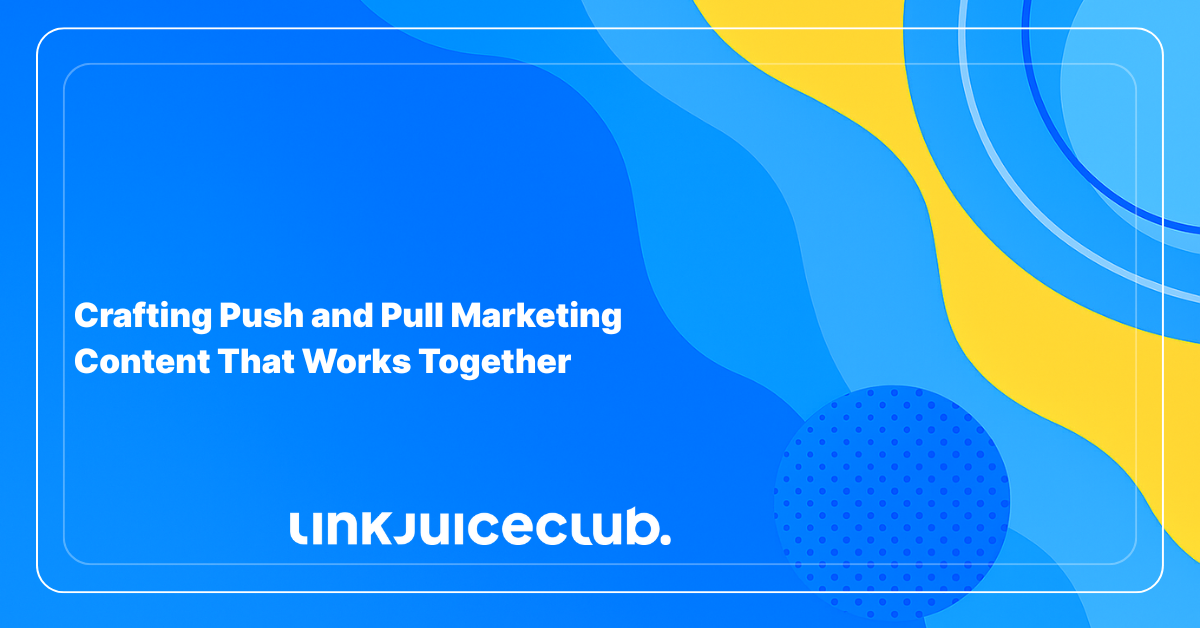
Crafting Push and Pull Marketing Content That Works Together
Before publishing your next blog, social post, or email blast, pause and think about the purpose behind it. Not every piece of content serves the same role—and understanding whether it fits into a push and pull marketing strategy can shape how well it performs.
Pull content is built to attract. It’s often optimized for search engines, designed to draw people in through organic discovery. Think of it as the backbone of inbound marketing—articles, guides, or resources that answer real questions and meet people where they are. Instead of interrupting someone’s day, it quietly positions your brand as the solution they were already searching for.
Push content, on the other hand, is about putting your message directly in front of prospects. This includes ads, email teasers, and social media promotions crafted to send people toward your site or your longer-form “pull” pieces. Push tactics don’t wait for demand—they spark it, nudging people to take that first step toward learning more.

In practice, push and pull marketing work hand in hand. Push content generates awareness and interest, while pull content captures that intent and converts it into engagement or sales. The key is knowing which type of content you’re creating and aligning your marketing approach accordingly.
Defining the Purpose Behind Every Piece of Content
Every piece of content has a purpose, even if you haven’t put that purpose into words yet. Before drafting anything, it’s worth asking: what is this supposed to achieve? The answer shapes whether you should lean on push tactics, pull strategies, or both.
Common objectives include:
- Building brand awareness and visibility
- Positioning your team as industry experts
- Improving search performance for a target keyword
- Driving downloads, sign-ups, or other conversions
- Sharing in-depth product knowledge
- Boosting engagement with your audience
- Bringing qualified traffic to your website
Once the goal is clear, it becomes much easier to decide whether push or pull content will get you there.
Push Marketing in Action
Push marketing content is about putting your message directly in front of people. It’s proactive, promotional, and designed to spark interest quickly. Common examples include:
- Paid social ads – Sponsored posts designed to reach new audiences at scale.
- PPC campaigns – Search engine ads that push traffic to your site.
- Promotional emails – Newsletters or blasts highlighting new offers or content.
- Email placements – Paid spots in third-party newsletters.
- Sponsored editorials – Advertorials in digital or traditional media outlets.
- Signage and displays – Billboards, flyers, or in-store materials.
- Endorsements – Content featuring influencers, celebrities, or trusted experts.
- PR coverage – Press releases, mentions, or guest articles.
- Backlinks – Links placed on other websites pointing users toward your content.
- Referral content – Ratings, reviews, or testimonials shared by existing customers.
Pull Marketing in Action
Pull content works differently. Instead of interrupting, it draws people in by answering questions or solving problems they’re already thinking about. Examples include:
- Landing pages – SEO-optimized pages built to capture organic traffic.
- Blogs and articles – Informational posts tied to industry topics or search queries.
- Social media content – Educational or entertaining posts that go beyond promotions.
- Email newsletters – Value-driven content for subscribers who chose to hear from you.
- Whitepapers – Long-form, data-rich resources that establish authority.
- Case studies – Real-world stories proving your product or service delivers results.
- Videos – Educational or how-to content that makes complex topics easier to digest.
Both push and pull content have unique strengths. The most effective strategies combine them—sparking awareness with push, then capturing intent with pull.
Deciding Between Push and Pull Marketing
There’s no one-size-fits-all answer here. The right approach depends on what you’re selling, who you’re trying to reach, and the outcomes you’re chasing. Here’s how the two strategies stack up in different scenarios:
Business Goals
Push tactics are ideal when you need fast results—like driving a quick sales spike or promoting a limited-time offer. Pull marketing, by contrast, is about building staying power. It slowly attracts an audience and nurtures relationships that pay off over the long term.
Market Interest
Push works best when you’re promoting something people already know and want. It amplifies existing demand. Pull is different—it creates demand where little to none exists, introducing audiences to products or ideas they may have never considered before.
Brand Positioning
If you’re a new business trying to break through the noise, push campaigns can generate that early visibility. For established brands, pull marketing leverages credibility and loyalty to keep customers engaged and coming back.
Product Type
Everyday products that don’t need explanation—like household staples—fit well with push strategies. Unique or specialized products, however, benefit more from pull content that educates, informs, and convinces customers to explore further.
Budget Factors
Push often comes with higher upfront costs since it leans heavily on paid placements and advertising. Pull usually costs less, but it requires consistency and patience to gain traction through organic channels.
Key Questions Before You Create Push Content

Push content only works when it’s intentional. Before writing, step back and ask yourself a few defining questions.
First, what is the exact goal of this piece?
Are you announcing a product launch, boosting brand culture, or sharing something fun to spark engagement? Defining the goal gives the content a clear purpose and prevents it from feeling scattered.
Second, where will this content be shared?
A press release across news outlets, a teaser in your company newsletter, or a LinkedIn update all require different tones and formats. Mapping out distribution channels before creating ensures the content fits every space naturally.
Key Questions Before You Create Pull Content
Pull content succeeds when it captures search intent, and that requires sharp planning. Ask yourself these critical questions before you begin.
What is the primary keyword phrase?
Without a target keyword, you’re essentially writing blind. Identifying it upfront anchors the content and guides optimization.
Is there real search demand behind the keyword?
Even a top ranking won’t help if nobody is searching for the term. Verify search volume so your effort translates into actual traffic.
Are you using the same wording your audience uses?
It’s not about what you call it—it’s about how they search for it. Using the optimal, commonly searched phrasing increases your chances of visibility.
Does the site already have content targeting this keyword?
If so, you risk keyword cannibalization, where multiple pages compete against each other. Checking for overlap first ensures you strengthen your rankings instead of diluting them.
Why Push and Pull Marketing Content Works Better as a Pair
Content doesn’t succeed in a vacuum. Push and pull both have their place, and ignoring either one means leaving opportunities on the table. A smart strategy connects them so your brand shows up where people are searching and also stays visible when they’re not.
Push content works best when it gives extra reach to pull content. A guide that earns search traffic will have a bigger impact if it’s also promoted in a newsletter or spotlighted on social. On the other side, push campaigns are stronger when they direct people to a library of useful, evergreen resources instead of a dead end.
The combination matters because each type fills a gap the other can’t cover. Pull marketing builds trust and answers questions in real time, while push marketing creates awareness and keeps your name top of mind. Together, they give people a reason to pay attention and a path to keep coming back.
The takeaway is simple: don’t pick sides. Use both approaches in tandem, and you’ll end up with more brand recognition, better engagement, and higher-quality leads. When push and pull work together, your content isn’t just visible, it’s effective.
Want Help? Partner With Link Juice Club
At Link Juice Club, we take a strategic approach to content that goes beyond one-size-fits-all templates. Every business has different goals, audiences, and growth challenges, which is why our team builds content plans designed around the full customer journey.
We balance push tactics that spark awareness with pull strategies that capture intent. This approach ensures your brand appears at the right moment. Whether someone is discovering you or actively comparing solutions.
By combining creative storytelling with data-driven SEO, we craft content that moves people from curious browsers → to engaged leads → to loyal customers. And because we see ourselves as an extension of your business, we’re not just focused on campaigns that look good—we’re focused on results that last.
If you’re ready to transform the way you use content, reach out to Link Juice Club. Together, we’ll create marketing that works harder, reaches further, and builds real connections with your audience.





